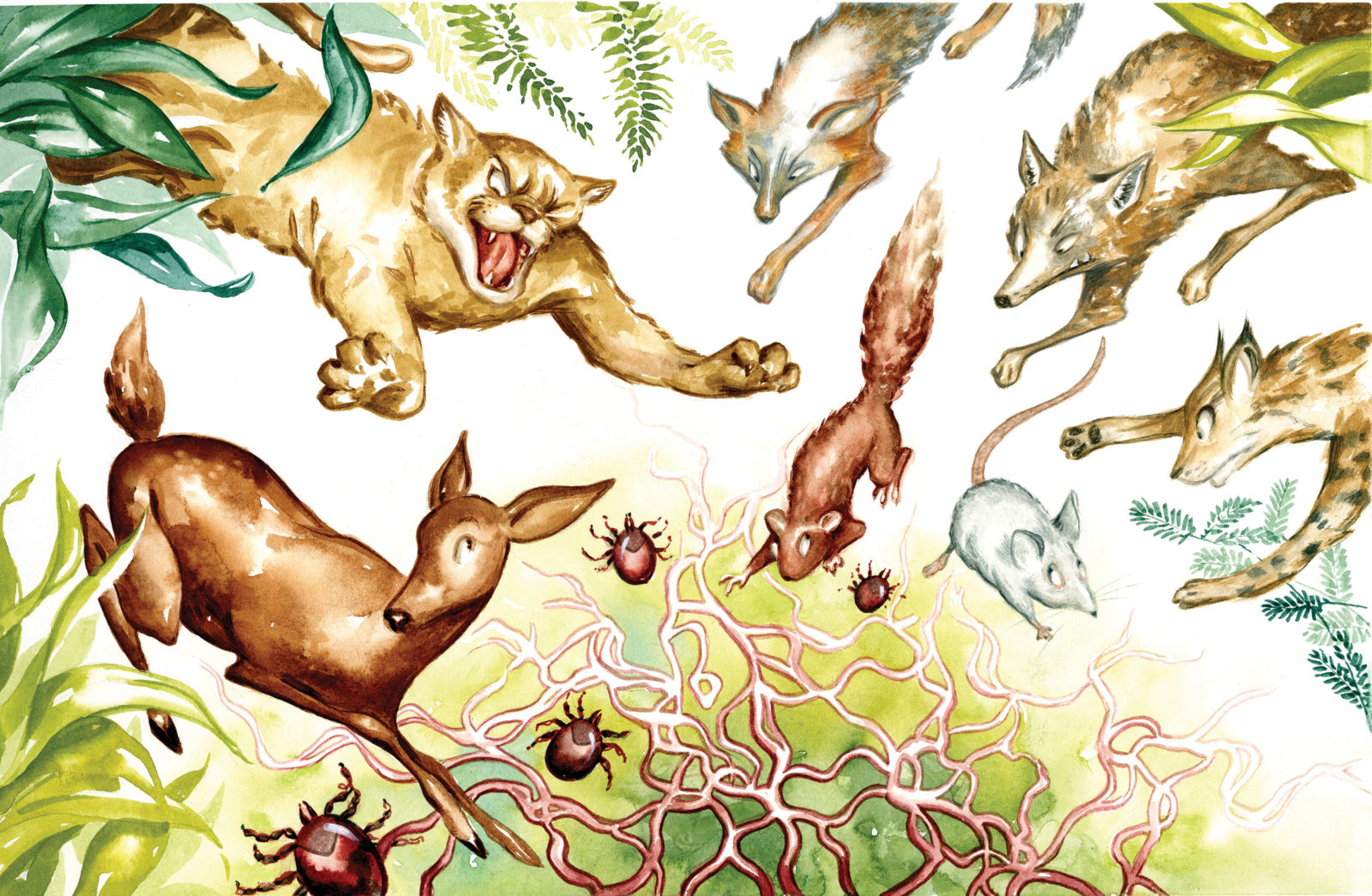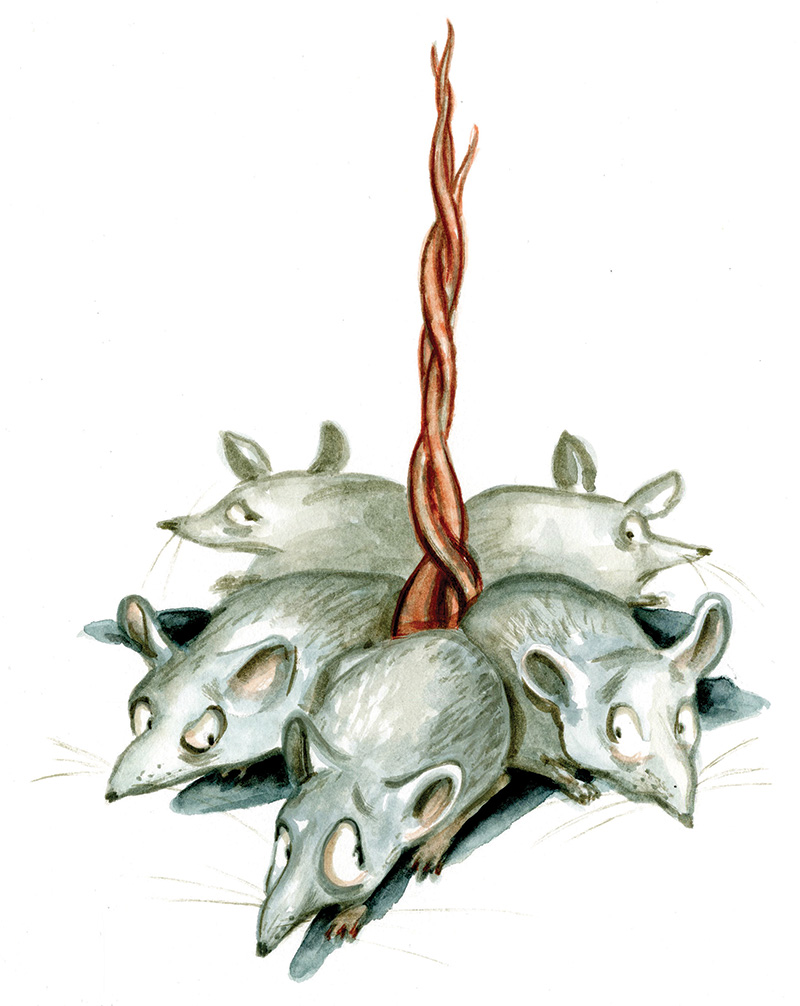
To deliberately attract a tick, you need to emulate a large animal—which shouldn’t be that hard because humans are essentially big, lumbering apes. You increase your chances of attracting the blood-sucking parasite by doing what Ceili Peng, manager of the Swei Lab at San Francisco State University, calls “the wedding walk”: proceed slowly in a straight line while also occasionally roughing up the leaf litter with your shoes like a clumsy deer. That way the ticks are sure to notice you passing.
The coup de grace is heavy breathing. The ticks have sensory pits on their front arms called Haller’s organs that allow them to detect the carbon dioxide you exhale. Trace amounts of this and other gases set them to “questing.” They climb the nearest twig or blade of grass and wave their arms around, trying to grasp the animal they know is moving through.
Peng demonstrates the wedding walk one beautiful January day, breathing heavily and dragging behind her a 1-meter-square white cloth to collect the ticks. We’re at China Camp State Park in Marin County, where Andrea Swei, head of the lab Peng manages, has spent 17 years studying the relationship between, among other things, biodiversity and the prevalence of Borrelia burgdorferi, the bacterium that causes Lyme disease.
Lyme disease, which is transmitted by tick bites, is currently the most common vector-borne disease in the U.S.; more than 300,000 people are infected yearly. Swei’s research could help illuminate both why the prevalence of Lyme has increased so dramatically in recent decades, mostly in the Northeast and upper Midwest, and also why Lyme remains much less common in California.
Climatic differences are almost certainly involved. California is much drier than the Northeast and ticks need ample moisture to survive. Lyme is also probably underdiagnosed in California; doctors in the state are less familiar with it than those on the East Coast. But as we walk through the oak woodland—prime tick habitat—Kacie Ring, a graduate student in Swei’s lab, explains how she knows Lyme is actually less prevalent in these parts.
Tick infection rates vary tremendously from place to place and year to year, but Swei’s research suggests a prevalence of between 5 and 10 percent around the Bay Area. And it’s likely lower in Southern California. By contrast, around 45 percent of ticks test positive for Lyme in many parts of the Northeast. “We have the hard data,” Ring says.
A better understanding of why ticks in these parts tend to harbor Lyme so much less often could, if the lessons are generalizable, point the way toward limiting the spread of the disease, for which there’s currently no vaccine. “It can be hard to diagnose and treat,” says Ring. “We need to better understand how to prevent it.”
One hypothesis the Swei Lab is pursuing is that the structure of the ecosystems in California, which are somewhat less disturbed and more intact compared to the Northeast, and the presence of certain key animals may limit the spread of the bacterium. Swei’s research could thus have big implications not just for Lyme disease, but for conservation generally. Biodiversity may have an under-recognized role in keeping people healthy by limiting certain infectious diseases.
The emergence and spread of the “COVID-19” coronavirus, which probably came from bats, is a good reminder that throughout history ecology has often driven infectious disease. To see the relationship, you just need to loosen how you define an ecosystem.
The first pandemic diseases emerged thousands of years ago in Egypt and elsewhere, evidenced first in writing and then in human remains. By then, well into the age of agriculture, people were living in more densely populated settlements than in earlier times, often in close quarters with newly domesticated animals. Clear-cutting, plowing, and irrigation had transformed the landscape. Together these changes probably facilitated the jump of pathogens from animals to people; most of the great pandemics are caused by microorganisms that originated in wildlife.
Smallpox, among the deadliest pathogens in human history—the virus killed nearly a third of the people it infected—likely descends from a virus native to camels. Measles followed a similar trajectory, hopping from cows. And judging from genetics, the most virulent strain of malaria, Plasmodium falciparum, moved from great apes to people at some point in the past 10,000 years, presumably transferred by an African mosquito that fed on a gorilla and then a person.
In a previous era, maybe the malaria-causing parasite would have died out in its new host, unable to find a new person to infect. But clearing and irrigation of land for agriculture likely changed the landscape, producing many sunlit puddles of the sort that favor the human-adapted mosquito. Enabled by this altered ecology, malignant malaria eventually hopscotched out of Africa, around the Mediterranean, and across South Asia.
Then in the 14th century came the bubonic plague. Perhaps the best analog for Lyme disease, the bacterium is native to marmots and other rodents in the steppes of Central Asia. Some shift in human activity—trade along the Silk Road, perhaps, or the mass migration of people within the Mongol empire, at that point the largest ever to have existed—freed the microbe from its Central Asian home.
Yersinia pestis, or plague, would ultimately kill at least one-third of the Eurasian population. Although the idea has recently been challenged, scientists have historically blamed rats, which likely flourished in human settlements, for aiding the outbreak of the plague. That shadow population of rodents in the nooks and crannies of buildings and sewers was a precondition, the disease reservoir. Fleas transferred the infection from these rodents to people. A skewed ecology may have enabled the Black Death.
What the major pandemics of history teach us is that how we shape the ecosystems around us, whether by newly introducing certain animals into the human orbit or inadvertently encouraging creatures like rodents and mosquitoes to proliferate, can greatly increase our exposure to infections. This dynamic continues to this day.
The emergence of new infectious diseases, particularly “zoonotic” ones that jump from animals, accelerated in the 20th century. Most of the big scares of modern times—SARS, MERS, Ebola, HIV and coronavirus—originated in animals.
One probable reason for the growing number of zoonoses is that a large and growing human population is coming into contact with more wild and domesticated animals than ever before, increasing the odds of what the science writer David Quammen calls a spillover. But another possible reason is subtler: the erosion of biodiversity.
Humans tend to affect ecosystems in predictable ways. First the large animals go; then the medium-size ones dwindle; finally, mainly small animals remain. Some argue that these small animals, the rodents and bats of the world, tend to be the very species that can pass infections to humans. The implication is that human activity inadvertently makes the wild disease-scape more virulent.
And that’s where the story of Lyme begins.

Borrelia burgdorferi, the microbe that causes Lyme, is not a new arrival to the human body. Ötzi, the 5,300-year-old mummy discovered in an Italian glacier, had the infection. But something about Lyme seems to have changed around the mid-20th century.
A doctor near Old Lyme, Connecticut, first described the disease in 1975: a mysterious illness that featured malaise, arthritis-like joint pain, and occasionally neurological problems. Infectious disease doctors eventually linked the ailment to a corkscrew-shaped bacterium transmitted by black-legged “deer” ticks. After that initial description, the number of reported infections soared, increasing roughly fourfold in the past 30 years or so.
Some of that increase likely stems from improved awareness. You can’t diagnose a disease unless it’s described first. But scientists have worked out another explanation for the rise of Lyme in the Northeast. And it begins, paradoxically, with ecological recovery.
Nearly clear-cut during European settlement, northeastern forests finally began to regrow as farming moved west in the 19th century. Parts of the Northeast are now more forested than at any point since Colonial times. But the ecological diversity of these young forests remains relatively depleted, a problem made worse by widespread fragmentation of the landscape. The very animals that tend to be infected with Lyme disease in the Northeast—mice and chipmunks—thrive in fragmented landscapes. Other animals that might control the number of Lyme-infected rodents, like weasels, are relatively scarce. These small hunters are very sensitive to forest disturbance, says Rick Ostfeld, an ecologist at the Cary Institute of Ecosystem Studies in New York, which may be one reason for their rarity.
Ostfeld has christened such animals “dilution hosts”: unlike rodents, which tend to amplify disease, they reduce disease prevalence. And they’re not all hunters. The opossum, for example, is immune to Lyme and thus won’t transmit it to ticks. And it grooms itself so obsessively that it serves as a tick death trap, reducing the number of ticks on the landscape: any tick unlucky enough to end up on an opossum pelt is probably destined to become a snack.
To compound the issue, a predator that has returned, the Eastern coyote, may be making things worse. Originally from Canada, this coyote is a hybrid. One quarter of its genome comes from the gray wolf. The arrival of a large-ish predator should be good news, but Taal Levi, an ecologist at Oregon State University, thinks this oversize coyote is competing with and occasionally killing red foxes. Foxes specialize in hunting rodents. He’s found a rough correlation between high coyote densities in New York state and lower fox numbers and a higher prevalence of Lyme. By displacing foxes, coyotes may have changed the behavior and abundance of rodents—and aided the spread of Lyme, Levi suspects.
Together these findings suggest that the shape of northeastern forests, fragmented on the one hand and ecologically simplified (compared to precolonial times) on the other—and suffering from a paucity of predators large and small—has yielded an ecosystem perfectly tuned to churning out Lyme-infected ticks. That’s a great starting point for understanding what’s different about California.
One of the most important factors limiting Lyme in California, explains Andrea Swei, has nothing to do with biodiversity and everything to do with the weather. Ticks have four life stages: egg, larva, nymph, and adult. In the Northeast, the nymphs emerge from their leaf litter hideouts in spring, infecting the animals they feed on with Lyme. Younger larval ticks next arrive on the scene feeding on the same animals and picking up the infection. The Lyme transmission cycle in the Northeast is amplified simply because of this quirk in timing—because older, already infected ticks show up before younger uninfected ones.
In California, by contrast, tick larvae and nymphs begin feeding at the same time, making the younger ticks much less likely to encounter and feed on an infected animal. This different schedule probably has to do with California’s comparatively long dry season. Ticks are very sensitive to desiccation. They need to get their blood meal before the long hot, dry summer sets in. So in California their feeding season is shorter than their counterparts’ in the Northeast.
Biodiversity is also greater in California than in the Northeast, which may blunt the spread of Lyme. The existence of distinct microclimates—coastal, inland, hills, the Sierra—near one another has allowed for this greater variety of wildlife to evolve and coexist in California. Whereas three to four species of mice might live within a given area in California, there might be at most two species in the Northeast. Even the number of tick species is more diverse. The western black-legged tick, Ixodes pacificus, the species scientists worry about most when it comes to Lyme, is one of six tick species that feed on humans in the state and one of 48 tick species overall. (By comparison, the East Coast has three human-feeding ticks.) And not all these animals are equally susceptible to Lyme infection. So from the Lyme bacterium’s perspective, the greater variability in animals probably changes how easy it is to move from tick to host, and back to tick again. It acts like rough terrain might for a hiker, making passage through the landscape of bodies more difficult.
Then there’s our stealthy apex predator, the mountain lion. After decades of hunting and trapping, the mountain lion population began recovering in the 1970s, and the deer population, which reached a peak of 2 million in the 1960s, has declined by at least three-quarters over roughly the same period—partly because of mountain lions, Taal Levi suspects.
Deer do not carry the Lyme bacterium, so they can’t infect ticks, but they likely serve as a kind of all-you-can-eat buffet for the parasites, boosting their numbers and physically moving them to new areas. The relationship isn’t linear, according to Levi’s analysis. With each additional deer, you don’t get 100 extra Lyme-carrying ticks, for example. Rather, some evidence suggests there’s a threshold of deer density, around 10 deer per square kilometer, beyond which the population of infected ticks increases and then quickly levels off.
Much of the Northeast is way beyond that threshold, while several studies suggest that, in some parts of California, the deer population falls below it. Some of that difference may stem from the state’s drier climate, but Levi suspects mountain lions are also controlling the deer population. Each cat kills some 50 deer per year, or roughly one a week. (Research by UCSC scientists suggests that mountain lions near human settlements kill even more—up to 80—possibly because they’re constantly interrupted before they can eat and have to hunt again.) “It’s hard to imagine that mountain lions don’t play a role” in the relative scarcity of Lyme in California, Levi says. “They kill a lot more than the public thinks.”
Small predators are also abundant in California, including bobcats and gray foxes, famous for their tree-climbing ability. What strikes Swei is how close these many predators, mountain lions included, come to human settlements in California. “In our very suburban field sites, we have an amazing diversity of carnivores,” she says. Their mere presence might change the behavior of animals in a way that limits the spread of Lyme.
Swei has set up wildlife cameras at her 14 study sites around the Bay and, in a still unpublished study, finds that when predators are around, prey species tend to have fewer ticks. That’s not necessarily because tick-infested animals get eaten more, she thinks, but because they travel shorter distances in the presence of animals on the hunt. This dynamic, called the “ecology of fear,” could turn rodents into bigger homebodies.

Another unique aspect of California’s Lyme disease-scape may come down to dumb luck. In the Northeast, the main Lyme reservoir is the white-footed mouse. In California, a major source is the western gray squirrel. (Another is the dusky-footed woodrat.) But for reasons that aren’t entirely clear, when a tick bites a Lyme-infected squirrel, it’s much less likely to pick up the bacterium compared to one that bites an infected mouse in New York. In experiments, approximately 1 in 4 ticks acquires the infection from California gray squirrels, whereas 9 of 10 do when feeding on northeastern mice and roughly 1 of 2 in the case of chipmunks. “There’s no known host in California that’s nearly as infectious as on the East Coast,” says A. Marm Kilpatrick, an infectious disease ecologist at UCSC.
And then there’s the western fence lizard, a reptile with a storied relationship to Lyme in California. As we walked through the oaks that day at China Camp State Park looking for lizards, Ring and Peng shared tick-researcher war stories. One can stumble into a “larval bomb”: hundreds of tiny, just-hatched ticks crawl all over your clothes. Other times you struggle with the animals you catch. Gray squirrels, probably the most important rodent in California when it comes to Lyme, are notoriously difficult to catch for tick counts. They view the peanut butter-baited traps with suspicion, declining to enter sometimes for weeks. And when you finally get one, they’re impossible to hold. Adult woodrats, likely the second most important reservoir for Lyme, also thrash around and bite. “They’re tough. They know their rights. And they didn’t sign up for science,” said Peng.
“Oh, there’s one!” Ring announces as we pass through a small clearing.
“She’s got lizard vision,” Peng says, as I search in vain for the lizard. Finally I see it, a tiny silhouette on a sunny log across the clearing, maybe 20 feet away. Ring approaches quietly, arranges a dental floss noose at the end of an extendable fishing pole and, after a few tries and some encouragement from Peng—“If you can’t do it, no one can!”—finally loops the noose around the lizard’s neck from about 10 feet away.
It’s a healthy-looking male with two iridescent blue smears along its belly and one on the underside of its neck. (But no ticks; too early in the season, she says.)
The fence lizard is what Ring calls a “double agent” in the Lyme story in California. The saga of the animal begins in the 1990s when a UC Berkeley researcher named Robert Lane noticed that the ticks he pulled off fence lizards never seemed to carry Lyme. Through a series of experiments, he and his colleagues worked out that the lizard’s blood had unique proteins that killed the bacterium. Any tick that fed on a fence lizard was thus cleansed of the disease. And a lot fed on lizards.
When Lane and his colleagues put black-legged ticks in cages with mice and lizards, the ticks swarmed the lizards and mostly ignored the mice. (Ring’s field work has corroborated that preference. “I’ve pulled 100 ticks off a single lizard,” she says. On rodents, by comparison, she tends to find tick numbers in the single digits.)
Massive quantities of ticks feeding on a reptile that clears them of Lyme was a nice explanation for why the disease is so much less prevalent in California compared to the Northeast. But then Andrea Swei blew the story up.
For her graduate work, Swei removed lizards from a section of woodland at China Camp State Park and then monitored the prevalence of Lyme-infected ticks. Instead of Lyme infection increasing without lizards, the opposite happened; the number of infected ticks declined. “It was counterintuitive,” she told me. But the likely explanation was this: So many ticks feed on lizards that when you remove them from the landscape, the tick population plummets. With so many fewer ticks alive, the total number of infected ticks also declines. The end result is a lower risk of people encountering ticks that harbor Lyme.
Swei’s study lasted only one season; its conclusions are preliminary. She still doesn’t know how removing lizards might change Lyme in the longer term. Maybe as the ticks learned to feed on other hosts, Lyme would have gone up. So there may be a final twist in the fence lizard story.
Even if lizards increase the prevalence of Lyme on the landscape, Ring says, when it comes to humans, they still may be protective. That protection stems from a peculiarity in the life stage of ticks that tend to infect people.
Left undisturbed, ticks feed for about three days. Lyme takes between 36 and 72 hours to move from a feeding tick to a person. That leaves a large amount of time to notice the parasite and remove it before infection occurs. So people tend to get infected not by large adult ticks, which we spot (and freak out about and google frantically) and then remove, but by the much smaller poppy seed-sized nymphs we don’t notice.
As it happens, the young larval ticks really like dining on lizards. So when they molt to become nymphs—the life stage that tends to infect people—the ticks often don’t have Lyme. The implication is even if fence lizards increase the prevalence of Lyme-carrying ticks overall simply because they feed so many, Ring suspects that by preventing infection in the very life stages that tend to transmit Lyme to humans, fence lizards might actually protect humans from Lyme disease in California.
A few years ago, a team of biologists calculated how many car accidents the mountain lion, by controlling the deer population, would prevent in the Northeast if it recolonized the region. Over 30 years, the predator would save $2.13 billion in accident-related costs, they found, prevent 21,400 human injuries, and save 155 human lives.
No one has yet put a similar number on ecosystem-based Lyme prevention in California or anywhere else—on the preventive value of the mountain lion, bobcats, gray foxes, and overall biodiversity in California. And the truth is, the research exploring these complex relationships is still in its infancy; the estimate would be difficult to formulate. But the roughly 226-fold difference in the incidence of confirmed Lyme cases in 2018 between California and Connecticut suggests that number might be substantial. And it raises a question: Can California be proactive about limiting Lyme? Can we do more of what we’re already doing right?
Limiting landscape fragmentation might be a wise management policy going forward, and tolerance of predators large and small might be a good hedge against disease. “There’s great potential for harnessing dilution-effect thinking for management,” Rick Ostfeld told me.
Swei is also studying a newer area of disease ecology that could prove important: how the group of microbes inhabiting the tick gut—the tick microbiome—affects the spread of Lyme. Theoretically, manipulating these microbes could allow scientists to make ticks and other parasites resistant to the diseases they pass to people. In Australia, experiments have already begun with mosquitoes whose microbes have been tweaked so that they don’t carry the virus that causes dengue fever.
Such microbial communities represent another, until recently mostly overlooked, factor that may affect prevalence of disease. The research highlights the possibility that every level of ecological diversity—including the microbial community in a tiny parasite’s gut—may play a role in how people get sick.




